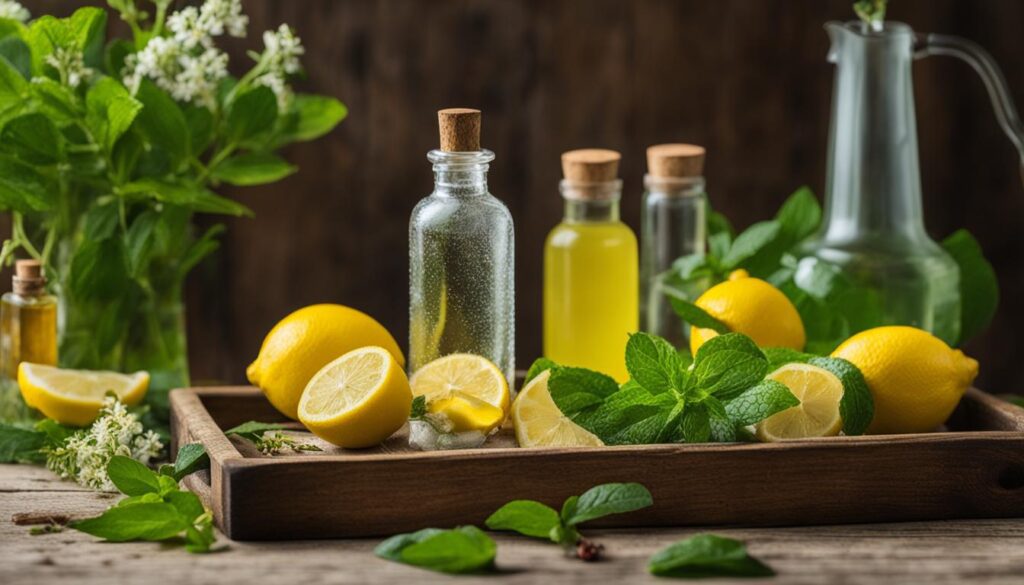Creating your own DIY natural pest repellents is a great way to protect your home from unwanted pests without resorting to harmful chemicals. By using ingredients like essential oils and common household items, you can make effective and non-toxic bug sprays that are safe for you, your family, and the environment. In this guide, we will provide step-by-step instructions for making DIY natural pest repellents that are not only effective but also easy to make.
Key Takeaways:
- DIY natural pest repellents are a safe and effective alternative to commercial bug sprays.
- Using essential oils and common household ingredients, you can create non-toxic bug sprays.
- Protect your home and garden from pests with homemade insect control solutions.
- Implement companion planting and promote plant diversity to reduce the need for bug sprays.
- Incorporate sustainable gardening practices for a natural pest control remedy.
The Power of Essential Oils: Effective and Safe Natural Repellents
Essential oils are a game-changer when it comes to DIY natural pest repellents. These concentrated plant extracts pack a powerful punch against insects while offering a safe and natural alternative to chemical-laden repellents. One standout essential oil is lemon eucalyptus oil, which has been proven to be the most effective natural mosquito repellent. Its efficacy is backed by the U.S. Environmental Protection Agency (EPA) and recommended by the Centers for Disease Control and Prevention (CDC) for its effectiveness and human safety.
In addition to lemon eucalyptus oil, other essential oils like citronella, eucalyptus, and peppermint can also ward off different types of insects. Citronella oil, derived from the lemon-scented grass, is commonly used to repel mosquitoes. Eucalyptus oil, with its strong scent, can deter fleas and ticks. Peppermint oil, known for its refreshing aroma, is effective against spiders and ants. By harnessing the power of these essential oils, you can create a natural bug spray that not only keeps pests at bay but also leaves a pleasant fragrance in the air.
Essential oils are not only effective natural repellents but also offer a range of additional benefits. They can uplift your mood, promote relaxation, and even soothe minor irritations on the skin. This makes them a versatile and valuable addition to your DIY pest control arsenal.
How to Use Essential Oils for Natural Pest Repellents
There are various ways to use essential oils as natural pest repellents. One simple method is to mix a few drops of your chosen oil with water in a spray bottle and apply it to areas where pests tend to gather, such as doorways, windows, and outdoor seating areas. Alternatively, you can create homemade repellent candles by adding essential oils to melted soy or beeswax and pouring the mixture into candle molds.
When using essential oils topically, it’s important to dilute them with a carrier oil, such as coconut oil or almond oil, to prevent skin irritation. A general rule of thumb is to mix 1-2 drops of essential oil with 1 tablespoon of carrier oil. Apply the diluted mixture to your skin or clothing to keep insects at bay while enjoying the outdoors.
| Essential Oil | Uses |
|---|---|
| Lemon eucalyptus oil | Repels mosquitoes |
| Citronella oil | Deters mosquitoes |
| Eucalyptus oil | Repels fleas and ticks |
| Peppermint oil | Wards off spiders and ants |
With the power of essential oils, you can create effective and safe natural pest repellents that protect you, your family, and the environment from unwanted insects. These DIY solutions not only offer peace of mind but also add a touch of aromatherapy to your pest control routine.

Homemade Bug Sprays: Simple and Effective Solutions
When it comes to keeping pests at bay, homemade bug sprays are a convenient and eco-friendly option. By using common household ingredients, you can create effective solutions to repel insects and protect your plants. Let’s explore some simple and natural bug sprays that you can easily make at home:
Insecticidal Soap
Insecticidal soap is a powerful remedy against a wide range of pests, including aphids, mites, and thrips. This homemade spray is made by combining vegetable oil and dishwashing soap. The oil suffocates insects, while the soap helps the solution adhere to their bodies. To make insecticidal soap, mix one tablespoon of vegetable oil and one tablespoon of dishwashing soap in a spray bottle filled with water. Shake well before using and spray directly on the affected plants.
Neem Oil Bug Spray
Neem oil is a natural insecticide derived from the seeds of the neem tree. It is effective against pests like mites, whiteflies, and mealybugs. To make neem oil bug spray, mix one teaspoon of neem oil and a few drops of dishwashing soap in a spray bottle filled with water. Shake well before using and spray on the affected plants. Neem oil not only repels pests but also disrupts their life cycle, making it an excellent long-term solution.
Vinegar Spray
Vinegar is a versatile ingredient that can be used as a bug repellent for various pests. To make vinegar spray, combine equal parts of vinegar and water in a spray bottle. You can also add a few drops of dishwashing soap to enhance its effectiveness. Vinegar spray works well against pests like ants, aphids, and fruit flies. Spray directly on the affected areas or plants to deter insects and keep them at bay.
Garlic Spray, Tomato Leaf Spray, and Cinnamon Spray
Other homemade bug sprays that can effectively repel insects include garlic spray, tomato leaf spray, and cinnamon spray. Garlic spray can deter pests like mosquitoes, aphids, and beetles. Tomato leaf spray is known to repel aphids, whiteflies, and caterpillars. Cinnamon spray can help keep ants, mosquitoes, and fungus gnats away from your plants. To make these sprays, you’ll need to research and follow specific recipes that suit your needs.
Experiment with these homemade bug sprays to find the ones that work best for your garden. Remember to test a small area of your plants before applying them extensively, as some plants may be sensitive to certain ingredients. With these simple and effective solutions, you can protect your plants from pests without resorting to harmful chemicals.

Creating a Balanced Garden: Companion Planting and Plant Diversity
When it comes to creating a sustainable and pest-resistant garden, plant diversity and companion planting play a crucial role. By incorporating a variety of plant species in your garden, you provide habitat and food sources for beneficial insects and animals that naturally control pest populations. Additionally, companion planting involves strategically placing compatible plants together to enhance their growth and deter pests. Let’s explore the benefits and techniques of both plant diversity and companion planting.
The Power of Plant Diversity
Plant diversity refers to the practice of incorporating different types of plants in your garden, including flowers, herbs, vegetables, and shrubs. This approach promotes a natural ecosystem by attracting a wide range of insects, birds, and other animals that contribute to pest control. By creating a diverse garden, you establish a balanced environment that encourages beneficial predators, pollinators, and parasitic insects that keep pest populations in check. Moreover, plant diversity enhances soil health, reduces the risk of disease outbreaks, and improves overall garden resilience.
Companion Planting for Pest Control
Companion planting is a technique used to maximize the benefits of plant interactions. Certain plant combinations repel pests, attract beneficial insects, and provide physical support to neighboring plants. For example, planting marigolds alongside tomatoes can deter aphids and nematodes while attracting hoverflies that feed on harmful insects. Similarly, interplanting beans with corn and squash forms the famous “three sisters” combination, where the beans fix nitrogen in the soil, while the corn provides a support structure and the squash acts as a groundcover that suppresses weeds.

Companion planting charts and guides are available to help you determine which plants are compatible with each other and which combinations offer the best pest control benefits. By strategically planning your garden layout and selecting companion plants that complement each other, you can create a harmonious and productive ecosystem that minimizes the need for chemical pesticides.
| Plant Combination | Pest Control Benefits |
|---|---|
| Tomatoes and Basil | Basil repels tomato hornworms and aphids |
| Carrots and Onions | Onions deter carrot flies, while carrots repel onion flies |
| Radishes and Spinach | Radishes act as a trap crop for flea beetles, protecting spinach |
By implementing plant diversity and companion planting techniques, you can create a sustainable and pest-resistant garden that thrives on natural ecosystem dynamics. Not only will this approach minimize the use of chemical pesticides, but it will also promote the health and productivity of your plants, ensuring a beautiful and abundant harvest.
Conclusion
DIY natural pest repellents offer a safe and effective solution for those seeking to control insects without exposing themselves or the environment to harmful chemicals. By creating your own homemade insect control products, you can ensure that the ingredients used are non-toxic and environmentally friendly.
These non-toxic pest deterrents are not only easy to make but also highly effective. By incorporating essential oils and common household items, you can create natural bug sprays that repel pests while leaving a pleasant scent. Say goodbye to commercial bug sprays filled with chemicals and hello to homemade alternatives.
In addition to DIY natural pest repellents, sustainable gardening practices such as companion planting and plant diversity can further enhance pest control in your garden. By creating a natural ecosystem, you can attract beneficial insects and animals that prey on pests, reducing the need for bug sprays altogether.
Protect your home and garden from unwanted pests by implementing DIY natural pest repellents and sustainable gardening techniques. Embrace the power of homemade insect control and enjoy a healthier, safer, and more sustainable way of managing pests.
FAQ
What ingredients are used in DIY natural pest repellents?
DIY natural pest repellents often use essential oils such as lemon eucalyptus, citronella, eucalyptus, and peppermint. Other common ingredients include vinegar, garlic, tomato leaves, and cinnamon.
Are DIY natural pest repellents effective?
Yes, DIY natural pest repellents can be effective in repelling pests. Essential oils have been found to be particularly effective, and homemade sprays like insecticidal soap and neem oil bug spray can also treat a wide range of pests.
Are DIY natural pest repellents safe?
Yes, DIY natural pest repellents are safe for you, your family, and the environment. They do not contain harmful chemicals commonly found in commercial bug sprays.
How do I create a balanced garden for natural pest control?
Creating a balanced garden involves plant diversity and companion planting. By including a variety of plants and utilizing companion planting techniques, you can attract beneficial insects and animals that prey on pests, creating a natural ecosystem that reduces the need for bug sprays.
How can DIY natural pest repellents and sustainable gardening practices protect my home and garden?
DIY natural pest repellents can keep unwanted pests away from your home without the use of harmful chemicals. Implementing sustainable gardening practices like companion planting and plant diversity can create a natural ecosystem that minimizes pest problems and promotes the overall health of your plants.